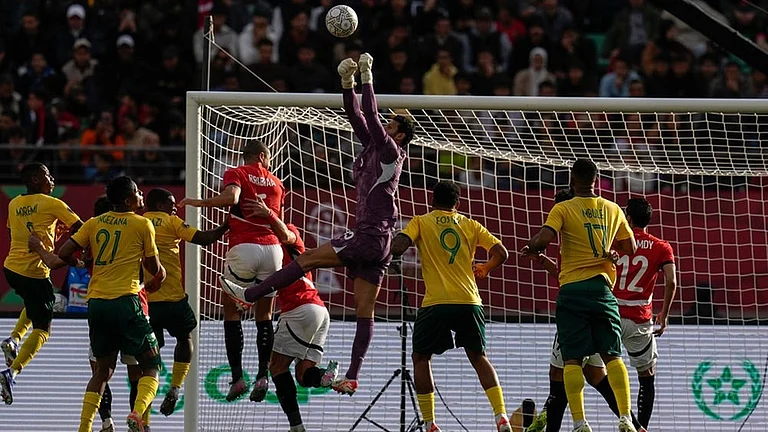Irony doesn’t get any more ironic. Communal polarisation has taken deep roots in the coastal belt of Karnataka, the state where assembly elections will be held in less than a fortnight. Yet, common people such as auto and taxi drivers, traders and street vendors in Mangalore are afraid to talk about religious issues. Instead, everyone talks about price rise of essential commodities, including petrol and diesel, and allegations of corruption against the Government. “It is very natural that people are scared to talk. The secular voices have been weakened. Be that as it may, the violent manifestation of Hindutva will be the most decisive factor for minority communities,” says Suresh Bhat Bakrabail, the former president of the Karnataka Communal Harmony Forum.
An uneasy calm prevails over the coastal region of Karnataka, which is a narrow strip between the Western Ghats and the Arabian Sea in the southwestern part of India. Despite the upcoming election, the region has not yet experienced the full fervor of campaigning. Both the ruling BJP and the opposition Congress are yet to stage rallies, roadshows and public meetings; the hot and humid weather is a major hindrance. Coastal Karnataka is a picturesque region that encompasses three districts—Udupi, Dakshina Kannada, and Uttara Kannada. It is renowned for its beautiful beaches, verdant forests, and rich cultural heritage. However, over the past 30 years, this region has witnessed the ascent of Hindutva and its aggressive expression through hate speeches, moral policing, desecration of places of worship belonging to minorities, and even physical assaults.
Even today, coastal Karnataka, known as the laboratory of Hindutva in the South, continues to engage in overtly communal activities. Just two weeks ago, the temple management committee of Bappanadu temple in Mulky, South Kannada District, imposed a ban on Muslim traders from participating in the temple trade. This decision was allegedly taken based on a memorandum submitted by local residents who wanted to keep the Muslim traders away.
The experiences of coastal Karnataka suggest that even the announcement of an election does not dissuade Hindutva groups to engage in polarising activities. In fact, elections tend to make the polarisation project more active than ever.
The coastal region of Karnataka has been the hotbed of communal tensions since early the 1990s. Though RSS had roots in the region since 1940s, the tangible Hindu-Muslim polarisation started in the early 1990s, which was triggered by the Ram Janmabhoomi campaign of L K Advani’s Rath Yatra and the subsequent demolition of the Babri Masjid. “The Sangh Parivar has always been at work at the ground level, while the secular forces took time to realise this,” says Pattabhirama Somayaji, a Mangalore-based retired professor who has been an active member of the Karnataka Communal Harmony Forum. Somayaji, who has often been a target Hindutva fringe groups, holds the view that secular political parties like Congress and other civil society movements failed to understand the ground level realities since the beginning.
Politics Over ‘Gauraksha’
“Gauraksha”, which has been a political project of the Sangh since the 1950s, was one of the strategies used to accelerate the Hindu-Muslim polarisation in the coastal region of Karnataka, post the 1990s. The first such incident was reported in March 2005, when a 60-year-old Muslim and his son were paraded naked and beaten by a group of cow vigilantes for “transporting cattle”. As Somayaji points out, this incident was a wake-up call to the political project of Gauraksha that had existed since the 1950s. A national cow week was observed by the RSS in 1952 in Udupi district, where a call to ban cow slaughter was made. Though violence in the name of cow protection was not visible till 2000, the region witnessed a spike in incidents of violence since 2005 against both Muslim and Christian minorities in the form of attacks on Churches, cow vigilantism, the bogey of love jihad and the moral policing of young couples.
Surathkal Riot: The Turning Point
“The Surathkal riot was a milestone in the growth of Hindutva in the coastal Karnataka region,” says Somayaji. Large-scale violence broke out on December29, 1998, in Surathkal, about 30 km north of Mangalore, when a group of Hindu fanatics pelted stones at the houses of Muslims in the area. The tension was triggered by a very trivial issue—a scrap seller was alleged to have stolen scrap from a house. However, this was the culmination of the tension built up over years since the Ram Janmabhoomi campaign and the demolition of the Babri Masjid. The Surathkal riot, in which six Muslims and two Hindus were killed, was one of the biggest in scale in the history of the region.
The resonance of the Surathkal riot spread out to neighbouring places as Puttur and Bantwal. According to a government report, 165 houses—98 belonging to Muslims—were destroyed in this violence. “One major factor that led to the growth of aggressive Hindutva is the laxity shown by successive governments towards such back-to-back incidents of violence. There were several commission report warnings in the aftermath of such communal polarisation, which were ignored by governments,” says Bakrabail. He pointed out that secular parties have been scared to address the aggressive manifestation of Hindutva.
The Ayodhya Of The South
According to secular activists such as Somayaji and Bakrabail, the capturing of Bababuden Giri Dargah was yet another major step that strengthened the aggressive polarisation of the Sangh Parivar. Bababuden Giri Dargah—it is also referred as Guru Dattatreya Bababuden Swamy’s Dargah—is one of the oldest Sufi Shrines in South India. The Dargah, which is termed as Datta Peeda by the Sangh Parivar and located on top of a hill in Chickmagalur district, was perceived as the symbol of syncretism in Karnataka. The shrine was worshipped by both Hindu and Muslim communities. A series of Rath Yatras towards the end of the 1990s—to liberate the shrine from the ”clutches of Muslims”—was launched by Sangh Parivar groups. It is significant that in 2002, the former Union Minister and BJP leader Ananth Kumar first declared Bababuden Giri as “the Ayodhya of the South”. “The glorious secular tradition of this region was severely affected by this declaration,” observes Bakrabail. In 2021, the Karnataka High Court permitted the appointment of a Hindu priest to the shrine. Eventually, this shrine, which was once perceived as a symbol of communal harmony, has now become a permanent source of tension, especially during the annual celebrations of Urs and Datta Jayanti.
Coastal Karnataka is also the birthplace of the conspiracy theory of love jihad that has today spread throughout the country and is being used as a powerful weapon to demonise Muslims. In 2009, Mangalore-based Hindu Janajagurun Samiti claimed that 30,000 Hindu women were converted into Islam by the love jihad project. The Samiti demanded an investigation into the reported cases of missing women who were allegedly “abducted for conversion”. However, a police inquiry followed by an order of the Karnataka High Court debunked the myth that Hindu women were being abducted for conversion through love jihad. The police said that a majority of Hindu women who went missing eloped with their Hindu boyfriends from other castes.
Despite sitting on multiple official findings that established that love jihad was nothing but propaganda, the BJP in Karnataka has continued to fan the communal embers. In January 2023, Nalin Kumar Kateel, the BJP state president who hails from the coastal region, allegedly urged people during a public rally to prioritise the menace of love jihad in this election over “small issues” like building roads, gutters and drainage.
The vandalising of churches, the banning of hijab in campuses has accelerated the momentum of the growing communal polarisation in the region. “The change that we are witnessing over the years is the absence of resistance,” says Sreenivas Kakkilaya, a secular activist and member of CPI. The voices of dissent and the secular collectives are fading away in the coastal Karnataka. Somayaji recollects the large-scale participation of people during the protests by secular forces against the attempt to claim Bababuden Giri Durgah. “Thousands of people participated in these protests, but now their voices have been silenced. Even when the hijab was banned, only a very few people protested,” says Somayaji.
As secular parties and civil society groups began to lose their relevance, Muslim organisations such as the Popular Front of India began to gain strength. “This is dangerous. Many secular activists went with them. This should not have happened,” says Bakrabail, who has been closely monitoring the incidents of communal clashes, cow vigilantism, moral policing and hate speeches since 2010. Muslim fringe groups have adopted the same aggressive methods of the Sangh Parivar groups, and this has only worsened the situation. For example, between 2012 and 2016, a number of incidents of moral policing by Muslim groups were also reported. They resorted to violence such as harassing Hindu-Muslim couples in public places as a means to assert their religious identity.
Bakrabail has meticulously collected data based on media reports of such incidents. His findings show that there has been a steady rise in all forms of hate mongering including physical assaults. According to his data, 1,582 such incidents took place across the coastal Karnataka region between 2010 and 2022. This includes 294 incidents of moral policing by Hindu vigilantes, 180 cases of cow vigilantism and 240 incidents of hate speeches.
The incidents of direct communal clashes such as vandalising places of worship and physical assaults are alarmingly high—about 700 cases between 2010 and 2022. On the contrary, the allegations of religious conversion show a declining trend despite the repeated hue and cry over the threat of love jihad. Since 2010, there have been only 76 incidents of allegations of conversion. The data also indicates that over the last three years (since 2021), there has been a tangible increase in all hate crimes including cattle vigilantism, hate speech and moral policing. In 2021, incidents of hate speech were 29; in 2022, it was 86.
(Edited by S.S. Jeevan)
(This appeared in the print as "Which Way the Wave in the Coast?")
Shahina K K in Mangalore


























